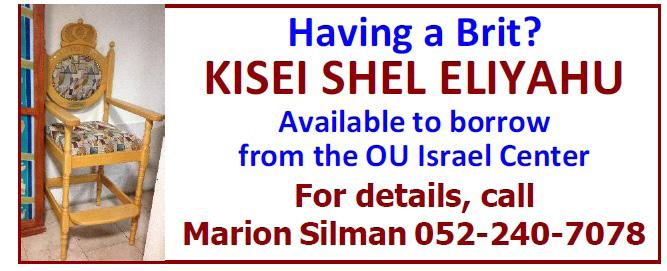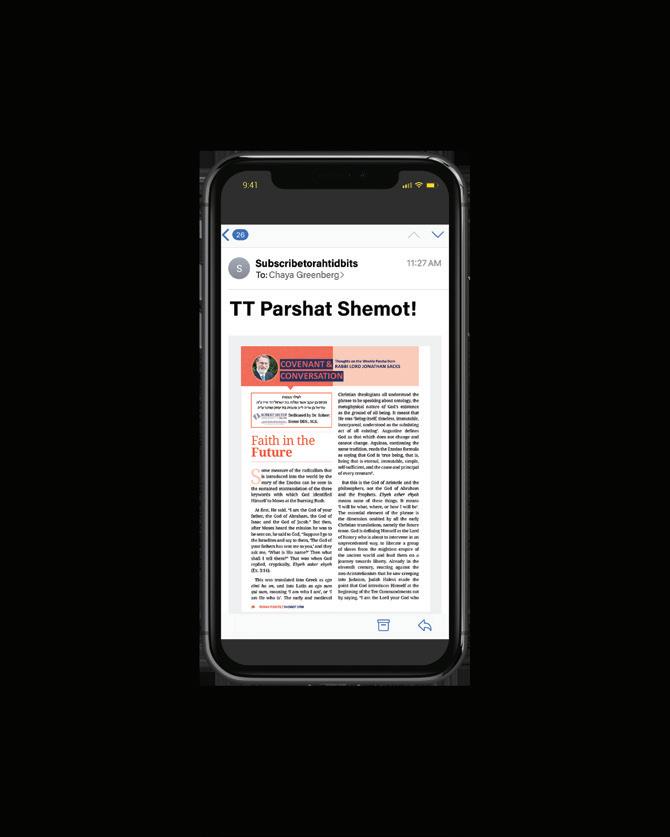
12 minute read
Trees, Visions, & Torah Scrolls Rakel Berenbaum
THE PORTION
Trees, Visions, & Torah Scrolls
Advertisement
Acouple of weeks ago I gave a lecture to a group of women. They asked what week I would be writing next in Torah Tidbits. When I told them that it would for T'rumah, some women gave me suggestions for possible recipes to include this week, most of them were very colorful. (BTW: I’m always happy to receive suggestions for recipes that would be relevant for a specific portion). They also were curious to know what I was going to write about in this week’s column. I must admit, that at the time I had no clue. Then I came across an amazing Rashi on the verse “ATZEI SHITIM OMDIM - And you should make the boards for the tabernacle of acacia-wood, standing up” (26:15).
The verse starts by saying “VASITA ET HKRASHIM – you should make the boards”. Rashi asks why the verse says to make the boards instead of just boards? With the added letter “H” it seems that there is something special about these boards. Rashi brings the Tanchuma that says, yes, these were special boards.
Yaakov, having descended into Egypt, knew that the slavery would begin soon. He also knew that the nation would be redeemed and they would eventually build the Mishkan. So he planted cedar trees in Egypt. Why? He was a visionary. He wanted those trees to be ready for the Jews to take with them during the Exodus from Egypt , to be brought along to be used for building the Mishkan. That’s amazing! Such planning for the future. Such a great way to instil hope into his children, before they even became slaves, that the nation would survive their time in Egypt, and that God would want to have a relationship with them.
This Rashi really inspired me – especially when I heard the story of the Hachnasat Sefer Torah done in the yeshuv of Bruchin by a 15 year old boy, Nave Schindler. He was 10 years old when the three boys were kidnapped and murdered in Israel. In those dark days of despair he decided that he would have a sefer Torah written in their memory. But how would he pay for the Torah scroll? Then and there he started selling candies. It took him 5 years of hard work to raise the 100,000 NIS to pay for the Torah scroll– but just a few weeks ago Nave wrote the last letters to complete that Torah. The parents of the boys said it was the most inspirational memorial service they had ever been to
As much as people complain about the lack of leadership today – we can console ourselves with the knowledge that there are people out there, such as Nave Schindler, who walk in the ways of Yaakov Avinu to have the vision to see better days in the future – and to work towards those days.
RECIPES
When I was a kid we always called broccoli “trees”. So this week’s recipe has broccoli in it since we talked about the trees used in the mishkan.
CHICKEN & RICE WITH BROCCOLI “TREES”
1 skinless, boneless chicken breast, diced
1 tsp. minced garlic 1 1/2 c. chicken broth 1 c broccoli, florets 1 red pepper, cut into thin strips 1 yellow squash, thinly sliced 1/4 tsp. black pepper 2 c. cooked rice
In a deep skillet, heat chicken, garlic, broth, red pepper and squash to boiling.
Stir in pepper and reduce heat. Simmer uncovered for 5-10 minutes. Stir in broccoli and rice and cook covered another 5 minutes. Add some boiled water if needed so it doesn’t burn.
The Next Generation of Dentists
Ozone Gum & Dental Therapy •Non- surgical approach •Restore gum health •Good for mild to severe cases •Prevent gum recession •Prevent bad breath •Prevent tooth extraction •Prevent root canal treatments •Better healing of implants

Located in Jerusalem city center
Call us now at: 02-6503208 054-9894707

ARNONA- new in the market 3 bedrooms ap, first floor, balconies, full renovation, easy access, spacious, unsuite, light + unit for rent only 2,420,000 nis ARNONA- 3 bedrooms, 100 s.q.m, elevator, 2 parking, storage, balcony, light & airy, 5 minutes from baka ARMON HANATZIV- ELKAHI -new in the market 3 bedroom, 90 s.q.m light, view, storage, a/c, only 1,420,000nis BAKA- Derech Chevron- Arabic house 2 bedrooms, private entrance, no steps, handicapped accesible, 50m garden, parking, walking dist. to Kotel and First Station, close to buses. Can be used as an office. 1,780,000 nis ARNONA- 4 bedrooms, 126 m, nicest in Arnona, reno- vated, breath-taking view, sukkah porch, spacious living room, Shabbat elevator, 2 parking spots, large machsan, central A/C, private heating OLD KATAMON- DUPLEX- 5 bedrooms, 150m +building rights, 2 Sukka porches 100 m, authentic Arab house, 4 air directions, very very special.
BY RABBI BENJI LEVY CEO Of Mosaic United
Inside Out
God commands the Jewish people to establish a dwelling place for him: ‘make for me a Sanctuary – so that I may dwell within them’ (Ex. 25:8). The use of the word ‘them’ seems strange. Surely, having begun by specifically referring to the Sanctuary, the Torah should read ‘so that I may dwell within it’ i.e. within the sanctuary, as opposed to dwelling ‘within them’ to be grammatically sound? Why the use of a plural term, when the sentence begins in singular form?
The Torah does not use a singular term since God is not referring to dwelling in one specifically constructed physical location. Rather, God is implying ‘among the Jewish people’ (Or HaChayim 25:8). God is commanding the Jewish people to create a space among the people, between and within their camps, in which He can dwell. As such, the commandment to build a sanctuary is more about God’s desire to be close to His nation wherever they sojourn, than about constructing a physical place for Him to dwell.
The Kotzker Rebbe has a somewhat different interpretation of this command. When asked where it is that God dwells, he answers, wherever we let God in. It is
up to each of us to make space for God in our lives, in our homes and in our hearts. If we can create the space and opportunity for God to enter, enter he shall. Thus, according to the Kotzker Rebbe, the purpose behind the plural language in the commandment: is to teach us that each member of the Jewish people is obligated to build a personal sanctuary in their heart, so that God will dwell within them (Rav Menachem Mendel of Kotzk, Itturei Torah).
These interpretations of God’s command to us to create a sanctuary for Him, leave us with the question of how. In what way should we be creating such an internal sanctuary? Some remarkable nuances in the construction of the ark which contains the Ten Commandments, the moral code of the Jewish people, serve as a blueprint for how we should construct this personal sanctuary for God within each of us.
When talking about the Ark, the Torah says, ‘you shall cover it with pure gold, from the inside and from the outside you shall cover it’ (Ex. 25:11). This description begs a few questions. First, why does the Torah initially refer to the inside and only afterwards to the outside? Secondly, why does the inside of the ark need to be covered with gold at all? Surely, we only see the outside and thus only the outside
The Talmud expounds on this verse, ‘any student of wisdom whose interior does not match his exterior is not a student of wisdom’ (Tractate Yoma 72b). Thus, the gold is required both on the inside and outside because it is imperative that both are congruent. Just as the ark, which symbolizes Torah knowledge, has gold on both the inside and the outside, so too a Torah scholar should not just speak wisdom on the outside, but internalize it on the inside.
The Torah says, ‘from the inside and from the outside’, in that order because we must start from the inside. We must start by first perfecting ourselves internally and only then, match our internal reality with external messages. The Torah specifies ‘pure gold’ because the values that we build on the inside and reflect on the outside should be sincere, pure ones.
By identifying these pure values, building them within and letting them radiate out, ultimately, we can transform ourselves into a fitting sanctuary where God can comfortably dwell within us as individuals and a collective.
Stay in touch with @RabbiBenji and learn more at www.RabbiBenji.com

BEIS DIN ןיד תיב

יו, ָר ֲח ַ א ֹ יתו ֵ ּ ת-ב ֶאְיו וָנ ָ ּ ת-ב ֶה א ֶ ּ וַצְר י ֶׁש ֲן א ַע ַמְיו, ל ִ ּ ת ְע ַדְי י ִּכ וגו טָ ּ פ ְׁש ִמ ּ ה ו ָק ָדְצת ֹ וׂש ֲעַ ה', ל ְ ך ֶר ֶ ּ ד ּ רו ְמ ָׁשְו בראשית יח:יט-
1 4 Eli yah u Salman St. N ach laot, Jeru salem 9451 1 1 6 14 ן מ לס ו ה ילא בו ח ר ם ילש ו ר י , ת ו אלח נ
TzdakaUmishpot@gmail.com www.TzdakaUmishpot.org +972 58-445-9684


BY TEENS
NCSY ISRAEL
Gavriel Novick Director of Regional Development, NCSY Israel
Giving It Your All
The first vessel of the Mishkan Hashem commands Moshe to create is the Aron. For the subsequent vessels, Hashem instructs Moshe using the word va’asita – and you shall make. Yet the word used by the Aron is va’asu – and they shall make. Why is this plural form used specifically for the Aron when Hashem is seemingly commanding an individual person, Moshe?
The Ramban answers, quoting the Midrash Rabba, that all of B’nei Yisrael were indeed commanded to take part in the building of the Aron. Those that could help with the formation of gold and wood should do so. However not all were skilled craftsman. What should the remainder of B’nei Yisrael do? The midrash continues to explain that there is another level. Those that didn’t have the craftsmanship needed could still help Bezalel, the Chief Building Officer. They could bring him his tools and a glass of water when he needed. And that is how they too could be a part of the Aron’s construction. Yet there were still others within the nation, perhaps the sick and elderly. How could they be involved? The midrash gives one final level for such individuals: they should have intent to be a part of the making of the Aron. Even in the situation where they couldn’t practically be there, they should want to be a part of it.
NCSY Israel is an organization dedicated to building holy vessels – to inspiring Jewish youth, a task so crucial it demands the involvement of the broader community. Each person will need to define their own level of support and
Purim is right around the corner! Plan your TT adver�sing accordingly
Purim/Parshat Tetzaveh Issue Deadline for adver�sing is Thursday February 27th, 12 PM
DOUBLE ISSUE
there will be some who practically cannot be actively involved at the moment. But it is important to realize that when faced with a crucial mission, we should all want to help in any way we can.
Shoham Orzach 10th Grade, Jerusalem
Ve’asu Li Mikdash Ve’shachanti Be’tocham
After giving the Torah at Sinai G-d asks Moshe to make him a Sanctuary, a portable tent-like spiritual place in the midst of the desert where He can dwell in. All of Israel were instructed to contribute toward the Mishkan. This commandment in Parashat T'rumah says “Ve’asu Li Mikdash VeShachanti BeTocham”. The verse does not say “and I will dwell within it,” rather it says, “and I will dwell within them,” within each and every one of them. This shows us that in addition to building the physical Mishkan, Hashem wants every Jew to make himself and his home a holy place so that He can dwell among us.
The building of the Mishkan is the model of how we should build our life. The Mishkan has to be built with physical instruments. It teaches us to use the tools around us for Avodat Hashem. Many of the Mitzvot are done with physical things such as Etrog, Candles, and Tefilin. The heart of the Mishkan is Kodesh Hakodashim, where the ark of the covenant was kept. And so should be in our own personal life and as a nation.
The study of the Torah should be in the center of our life and our house, because wherever the Torah is, that is where G-d is. Above the ark the two Keruvim do not look away but face each other. It teaches us about forgiveness and Ahavat Israel. The table in the Jewish home is compared to the altar and the Shabbat candles to the menorah. The more we are connected to Torah and Mitzvot, the more we will reach Kedusha and be filled with happiness, life, and prosperity.
“VeAsu Li Mikdash” is a commandment for generations. When the first Temple was completed, King Solomon received a prophecy from G-d: “this house which you are building, if you walk in My statutes, and execute My ordinances, and keep all My commandments to walk in them; then will I establish My word with you, which I spoke to David your father. And I will dwell among the children of Israel, and will not forsake My people, Israel.” This is the power of each and every Jew: to be a “Mishkan” for G-d by following the Mitzvot.
NCSY Israel is the premier organization in Israel, dedicated to connect, inspire, and empower teen olim to the Land of Israel by encouraging passionate Judaism through Torah and Tradition. Find out more at israel.ncsy.org

C o m i n g s o o n ! THE TORAH TIDBITS DIGITAL EDITION


Re a d & Pri n t y o u r Favo ri te C ol um n s


The same Torah Tidbits you've loved for decades soon available in your inbox
To subscribe send an email to subscribetorahtidbits@gmail.com














